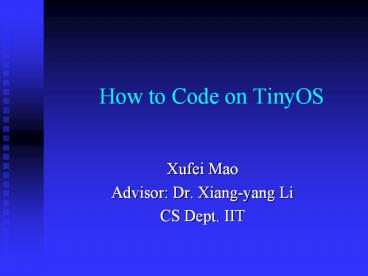How to Code on TinyOS - PowerPoint PPT Presentation
Title:
How to Code on TinyOS
Description:
... .pdf Reference TinyOS Tutorial by Jeremy Gummeson, Sensors Lab, UMass-Amherst TinyOS Programming by Philip Levis nesC paper: ... – PowerPoint PPT presentation
Number of Views:226
Avg rating:3.0/5.0
Title: How to Code on TinyOS
1
How to Code on TinyOS
- Xufei Mao
- Advisor Dr. Xiang-yang Li
- CS Dept. IIT
2
Outlines
- What is TinyOS?
- Hardware Software
- NesC
- A simple example
- Conclusion
3
So why do we need a new OS?
4
Traditional OS
- Huge !
- Multi-threaded architecture gtlarge memory
- I/O model
- Kernel and user space separation
- Typically no energy constraints
- Ample available resources
5
Sensor Hardware Constraints
- Lower Power
- Limited memory
- Slow CPU
- Size (Small)
- Limited hardware parallelisms
- Communication using radio
- Low-bandwidth
- Short range
6
Desired OS Properties
- Small memory footprint
- Efficient in power and computation
- Communication is fundamental
- Real-time
- Support diverse application design
7
TinyOS Solution
- Concurrency uses event-driven architecture
- Modularity
- Application composed of components
- OS Application compiles into single executable
- Communication
- Uses event/command model
- FIFO and non pre-emptive scheduling
- No kernel/application boundary
8
The Hardware
9
Software
- TinyOS (Platform)
- Coding language
- NesC (Network Embedded System C)
10
TinyOS Memory Model
- STATIC memory allocation!
- No heap (malloc)
- No function pointers
- No dynamic, run-time allocation
- Global variables
- Available on a per-frame basis
- Conserve memory
- Use pointers
- Local variables
- Saved on the stack
- Declared within a method
11
TinyOS nesC Concepts
- New Language nesC. Basic unit of code
Component - Component
- Process Commands
- Throws Events
- Has a Frame for storing local state
- Uses Tasks for concurrency
- Components provide interfaces
- Used by other components to communicate with this
component
12
Components
- Two type of components
- Module
- component written with code
- Configuration
- components wired together
13
Components
14
TinyOS Application (Sample)
15
Commands/Events/Tasks
- Commands
- Should be non-blocking i.e. take parameters start
the processing and return to app - postpone time-consuming work by posting a task
- Can call commands on other components
- Events
- Can call commands, signal other events, post
tasks but cannot be signal-ed by commands - Pre-empt tasks, not vice-versa
- Tasks
- FIFO scheduling
- Non pre-emptable by other task, pre-emtable by
events - Used to perform computationally intensive work
- Can be posted by commands and/or events
16
nesC
- Naming conventions
- nesC files extension .nc
- Clock.nc either an interface (or a
configuration) - ClockC.nc a configuration
- ClockM.nc a module
17
nesC Keywords
18
nesC Keywords -implementation
19
Interfaces
20
Modules
- Implement one or more interfaces
- Can use one or more other interfaces
21
Modules (Sample)
22
Configurations
- Two components are linked together in nesC by
wiring them - Interfaces on user component are wired to the
same interface on the provider component - 3 wiring statements in nesC
- endpoint1 endpoint2
- endpoint1 -gt endpoint2
- endpoint1 lt- endpoint2 (equivalent endpoint2 -gt
endpoint1)
23
Configurations (Sample)
24
nesC Wiring Syntax
25
Compile Run
- Compiler processes nesC files converting them
into a gigantic C file - Has both your application the relevant OS
components you are using - Then platform specific compiler compiles this C
file - Becomes a single executable
- Loader installs the code onto the Mote (Mica2,
Telos, etc.)
26
Simple Example 1
- Blink Application
- Blink.nc configuration
27
Simple Example 1
- Blink Application
- BlinkM.nc module
28
Simple Example 2
- Communication between two sensors
- Environment Xubuntu TinyOS 2.0
- Hardware TelosB sensors
29
Resources
- Gauravs TinyOS-1.x installation howto
- http//www.cs.umass.edu/gmathur/misc/tinyos_setup
.htm - Tinyos-2.x installation howto (straightforward)
- http//www.tinyos.net/tinyos-2.x/doc/html/install-
tinyos.html - The official TinyOS tutorial (pretty good)
- http//www.tinyos.net/tinyos-1.x/doc/tutorial/
- The offical TinyOS-2.x tutorial (very good)
- http//www.tinyos.net/tinyos-2.x/doc/html/tutorial
/index.html - nesC http//nescc.sourceforge.net/
30
Resources
- Other Docs
- nesC paper http//none.cs.umass.edu/gmathur/tiny
os/nesc-pldi-2003.pdf - nesC manual http//none.cs.umass.edu/gmathur/tin
yos/nesc-ref.pdf - TinyOS abstractions http//none.cs.umass.edu/gma
thur/tinyos/tinyosnsdi04.pdf
31
Reference
- TinyOS Tutorial by Jeremy Gummeson, Sensors Lab,
UMass-Amherst - TinyOS Programming by Philip Levis
- nesC paper http//none.cs.umass.edu/gmathur/tiny
os/nesc-pldi-2003.pdf
32
Conclusion































